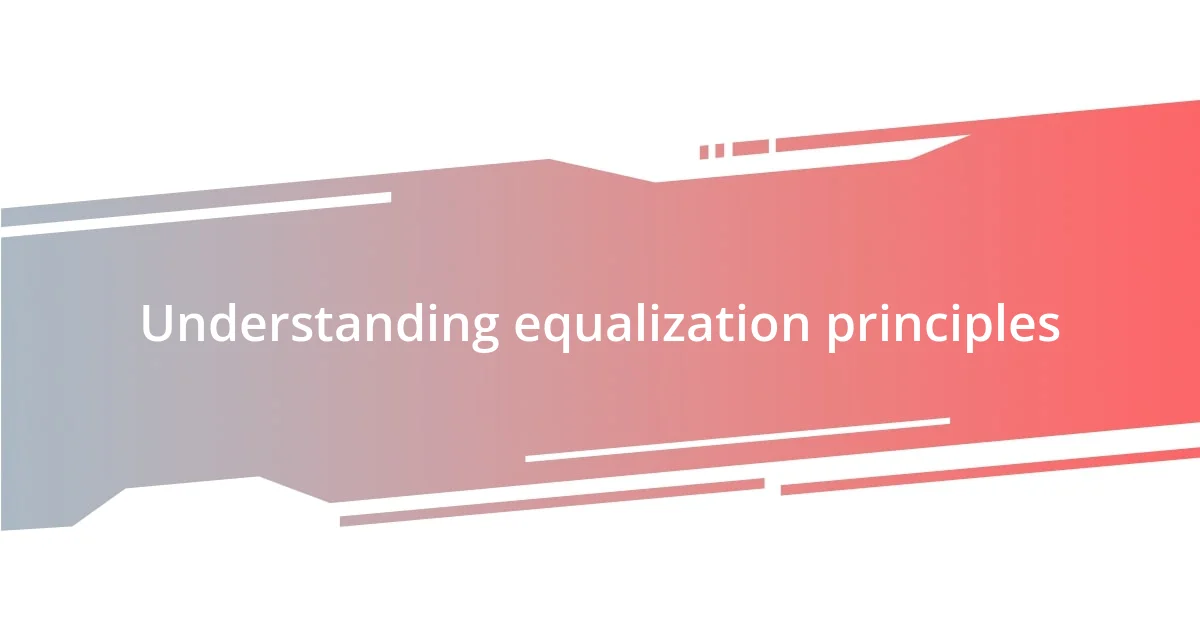Key takeaways:
- Equalization (EQ) is crucial for balancing sound frequencies, enhancing clarity, and crafting emotional impact in a mix; it requires both technical skill and artistic vision.
- Identifying frequency issues involves focusing on areas like low-end muddiness, vocal harshness, and frequency masking, allowing for effective adjustments that improve overall sound quality.
- Techniques such as using a spectrum analyzer, applying subtractive equalization, and leveraging automation enhance mix clarity and emotional resonance, leading to a more polished final product.

Understanding equalization principles
Equalization (EQ) is the art of balancing sound frequencies to create a polished final mix. When I first dove into mixing, I was overwhelmed by the range of frequencies—bass, mids, treble—all competing for attention. It struck me that EQ isn’t just about cutting or boosting; it’s about sculpting the sound to fit together harmoniously. Have you ever been in a situation where a track felt muddy? That’s precisely where understanding EQ principles comes into play.
To grasp EQ, I found it essential to think of frequencies like colors on a palette. Each frequency contributes to the overall picture, adding depth and character. When I mix, I try to visualize each element—like imagining a vibrant sunset versus a gray overcast day. It’s fascinating how a simple notch at 200 Hz can clarify a muddy bass line or how a slight boost at 8 kHz can bring a vocal to life. This concept transformed my approach, making me ask: “What do I want this element to express?”
In my mixing journey, employing EQ feels like storytelling. Each frequency choice conveys an emotion or intention. I remember the first time I used a high-pass filter to clear out unwanted low-end rumble; the clarity that emerged brought a smile to my face. It was like opening a window on a fresh spring day! Have you felt that rush when the right EQ setting clicks? The thrill of crafting something unique through EQ makes every session deeply rewarding.

Identifying frequency issues in tracks
Identifying frequency issues in tracks can sometimes feel like searching for a needle in a haystack. There are moments when I’ve hit play, and something just doesn’t sit right. I start tuning into various elements, honing in on where the mud lies. Often, it boils down to certain frequencies clashing. It’s like hearing a beautiful melody but feeling that something is slightly off-key.
When I’m looking for frequency issues, I focus on a few key areas:
– Low-end muddiness: Is the bass overwhelming? I check around 200 Hz where a lot of low-end messiness tends to reside.
– Harshness in vocals: If the vocals sound too abrasive, I pay special attention to frequencies around 3-5 kHz.
– Clarity in the mix: To ensure clarity, I listen for frequency masking, where sounds are colliding, typically in the mid-range around 500 Hz.
– Sibilance: I gauge how sibilant the vocals sound, often addressing around 7-10 kHz.
– Overall balance: A quick sweep with an EQ can help me identify any areas that feel too dense or sparse.
It’s a journey of discovery. I still recall wrestling with a guitar track that just wouldn’t blend. As I scoured the mix, I discovered a frisky 1 kHz spike competing with the snare. I carved that out gently, and suddenly, the track breathed. The realization that small tweaks can create such impactful changes continues to inspire me.

Techniques for frequency balancing
When balancing frequencies, one technique I often employ is using a spectrum analyzer. It’s like having a visual aid during a game of hide and seek with frequencies. This tool helps me spot problem areas that I might miss just by listening. I remember the first time I saw a stark spike on the analyzer; it was like a lightbulb went off! By addressing that specific frequency with a cut, I noticed a significant improvement in the overall clarity of the mix. It’s a powerful reminder of how visuals can guide us in making auditory decisions.
Another approach I find essential is using subtractive equalization before reaching for boosts. It’s tempting to boost frequencies to enhance a sound, but I’ve learned that cleaning up unwanted clutter is more effective. It’s similar to tidying up a room; once you clear out the distractions, what remains shines even brighter. The other day, I was mixing a track with several layers of guitar. After gently cutting some low mids, the entire arrangement felt more spacious. It’s fascinating how these small adjustments can lead to an exhilarating sense of balance.
Lastly, I often create frequency balance by carefully panning instruments and adjusting their EQ in the stereo field. This technique enhances separation and richness within the mix. Picture a band on stage—if they’re all clumped together, it can sound chaotic. However, when I pan guitars to one side and the vocals to the other while sculpting their EQ accordingly, it’s like giving each instrument its own spotlight. I vividly remember mixing a lively pop track where this approach drew the attentive focus of every listener. It turned an overwhelming blend into a harmonious ensemble that felt engaging and cohesive.
| Technique | Description |
|---|---|
| Spectrum Analyzer | A visual tool that helps identify problematic frequency spikes in a mix, allowing for precise cuts to enhance clarity. |
| Subtractive Equalization | Cleaning up frequencies by cutting unwanted elements before boosting others. This often results in a more balanced and polished sound. |
| Panning and EQ | Using stereo positioning and EQ adjustments to give each instrument its space, leading to a clearer, more cohesive mix. |

Applying EQ for emotional impact
When it comes to applying EQ for emotional impact, I firmly believe that the right frequency adjustments can transform a track from merely good to profoundly moving. I remember a time when I was mixing a ballad. By gently boosting the warmth around 250 Hz in the vocals, I could almost feel their vulnerability. It was as if that small adjustment breathed life into the performance, making the listener connect emotionally with the artiste’s story. Isn’t it fascinating how frequency can evoke feelings?
Another pivotal moment happened during a mix of an upbeat song. I decided to carve out some harsh frequencies around 3 kHz in the instruments, and the immediate clarity brought joy and energy to the track. It struck me that emotions can be enhanced simply by giving each element its space to shine. How often do we overlook that emotional connection in our mixes?
Moreover, I often use dynamic EQ to create moments of tension and release. In a recent project, I faced a particularly dynamic instrumental section where the clashes between instruments rose in intensity. By automating the EQ to duck the frequencies around 500 Hz during the main parts, I allowed the choruses to hit even harder. That contrast, that push and pull, had such a powerful emotional effect that it made me lean in closer. Isn’t that what we aim for in every mix—an opportunity for listeners to feel?

Tips for maintaining mix clarity
One of my go-to strategies for maintaining mix clarity is carefully managing the low end. I remember working on a dance track where the kick and bass seemed to compete for space. By applying a gentle high-pass filter to the bass, I allowed the kick to punch through, creating a sense of rhythm that made you want to move. It’s amazing how eliminating unnecessary frequencies can elevate the entire track, isn’t it?
Another crucial tip I often share is to leverage automation to control dynamic range. In one of my mixes, I noticed that the vocal performance was getting lost during the chorus, where the instrumentation intensified. By automating the volume adjustments and tweaking the EQ to slightly brighten the vocals during these moments, I could keep the listener engaged without sacrificing the mix’s richness. Isn’t it satisfying to see how small tweaks can make a huge difference?
Lastly, I find that referencing professional tracks in the same genre can provide invaluable insights. When I was mixing a recent indie pop project, I took a moment to compare my mix to some of my favorites. This practice revealed how my snare was too loud, overshadowing other elements. By adjusting my EQ and levels based on these references, I was not only able to achieve better clarity but also ensure that my mix felt cohesive and polished. Isn’t it interesting how stepping back can provide a clearer vision of what needs tweaking?















